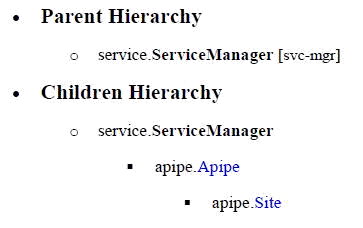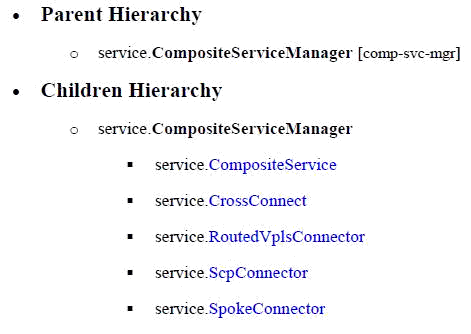Key packages and classes
Overview
The XML API interface uses the service.serviceManager class, which is the parent class for most of the service types, to manage services. See Figure 19-1, service.serviceManager (svc-mgr) class . When you create, modify, or delete a service, the distinguishedName and objectFullName start with svc-mgr if applicable. The FDN of the service.servicManager class is svc-mgr, and there is only one instance of this class from which the service objects inherit.
Note: The terms distinguishedName, instanceName, and objectFullName are used synonymously in the XML API to refer to the unique identifier of the object instance. See objectFullName element in Schema Reference for more information about the object full name.
Figure 19-1: service.serviceManager (svc-mgr) class

The packages for the service components are:
The XML API interface uses the service.CompositeServiceManager class to manage composite services. When you create, modify, or delete objects in a composite service, the distinguishedName and objectFullName start with comp-svc-mgr, if applicable. The FDN of the servic.CompositeServiceManager is comp-svc-mgr, and there is only one instance of this class from which the composite service objects inherit.
Figure 19-2: service.CompositeServiceManager (comp-svc-mgr) class

To understand the notation used for creating the distinguishedName, or how to fill in a pointer property, see the Help link in the XML API Reference. For example, when a distinguishedName is svc-mgr:service-${*id}:${siteId}, italicized items after the dollar sign and enclosed in parenthesis are the property value. The distinguishedName may be svc-mgr:service-10000:10.10.20.22, where the 1000 is the ${*id} and the 10.10.20.22 is the ${siteId}. The value for a pointer property is the object full name.
The XML API Reference specifies whether the properties need to be set during the creation of the object. The following figure shows that the property must be set when the object is created because access for the property siteId is read-create.
Figure 19-3: Sample siteID property settings

© 2024 Nokia. Nokia Confidential Information
Use subject to agreed restrictions on disclosure and use.